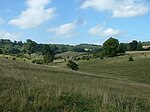Cholesbury

Cholesbury (recorded as Chelwardisbyry in the 13th century) is a village and former civil parish, now in the parish of Cholesbury-cum-St. Leonards, in Buckinghamshire, England, on the border with Hertfordshire. It is situated in the Chiltern Hills, about 4 miles (6.4 km) east of Wendover, 5 mi (8.0 km) north of Chesham and 5 mi (8.0 km) from Berkhamsted. Cholesbury is one of four villages comprising Cholesbury-cum-St Leonards parish. Braziers End is a hamlet which has always been closely associated with Cholesbury. It is a rural community and most local people rely for employment on neighbouring towns, the proximity of London and the availability of broadband technology.
Excerpt from the Wikipedia article Cholesbury (License: CC BY-SA 3.0, Authors, Images).Cholesbury
Cholesbury Lane,
Geographical coordinates (GPS) Address Nearby Places Show on map
Geographical coordinates (GPS)
| Latitude | Longitude |
|---|---|
| N 51.7546 ° | E -0.6521 ° |
Address
Cholesbury Lane
Cholesbury Lane
HP23 6ND , Cholesbury-cum-St Leonards (Chesham and Villages Community Board)
England, United Kingdom
Open on Google Maps










